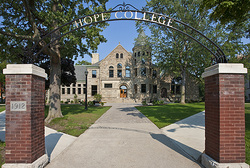Women at Hope College

Photo Courtesy of Hope College
One of the most integral elements of Holland, Michigan is Hope College. A small liberal arts college, Hope College was officially founded in 1866 by A. C. Van Raalte, the same man who founded Pillar Church and led the Holland community as the native Dutch created a life for themselves in the United States. Hope College is affiliated with the Reformed Church of America and boasts blue and orange as its colors, staying true to the conservative Dutch community.
The breakout of the war affected enrollment at Hope College, as most of the young men who had been students either enlisted or were drafted into the service. Hope had to suspend men's sports, dances, mixers, and the like. This did not mean, however, that women were allowed to fall into social laziness. An element of propriety was still expected--the dorms still had house mothers who enforced (or tried to enforce) the curfew. The dorms still had dinner together in the evenings and appropriate etiquette was still expected. Although genteel living was a standard, the college was far from stifling. In lieu of the absence of men at Hope, the women formed the Women's Activity League and even formed a women's football team.
The faculty was also affected by the demand for men and lost many faculty members to the cause. There was a surge in woman faculty and staff members to keep the college running; however, the women did not stop with just keeping Hope functioning, but made it a priority to gain recognition from the American Association of University Women. This goal was supported by the president at the time, Irwin Lubbers (the namesake of the current building dedicated to the humanities). The AAUW Holland branch was founded in 1938 by 23 women, with Mrs. James Warner as president. Although the beginning numbers were modest, membership and activity really took off once the war began. The German, French, History, Drama, and Art Departments, as well as the library, were all headed by women. These women also gave their time, talents, and goods to the community--locally, nationally, and globally. According to 75 Years of the American Association of University Women of Michigan, the members of AAUW in Holland amassed books for a drive called the Victory Book Campaign, began building a center for youth, volunteered for the Red Cross, and collected clothing and needed provisions and articles for the University Women of Norway, an occupied country.
After the war ended, enrollment at Hope College tripled as many of the former students returned, as well as many new male students who were able to pay their tuition thanks to the G.I. Bill. The spirit of women's strength began to fade into the background and Hope, once again, hired more men faculty. Janita Holleman, an influential woman at Hope College said that with the influx of men, an element of chauvinism grew and twice she was denied full-professorship.
The breakout of the war affected enrollment at Hope College, as most of the young men who had been students either enlisted or were drafted into the service. Hope had to suspend men's sports, dances, mixers, and the like. This did not mean, however, that women were allowed to fall into social laziness. An element of propriety was still expected--the dorms still had house mothers who enforced (or tried to enforce) the curfew. The dorms still had dinner together in the evenings and appropriate etiquette was still expected. Although genteel living was a standard, the college was far from stifling. In lieu of the absence of men at Hope, the women formed the Women's Activity League and even formed a women's football team.
The faculty was also affected by the demand for men and lost many faculty members to the cause. There was a surge in woman faculty and staff members to keep the college running; however, the women did not stop with just keeping Hope functioning, but made it a priority to gain recognition from the American Association of University Women. This goal was supported by the president at the time, Irwin Lubbers (the namesake of the current building dedicated to the humanities). The AAUW Holland branch was founded in 1938 by 23 women, with Mrs. James Warner as president. Although the beginning numbers were modest, membership and activity really took off once the war began. The German, French, History, Drama, and Art Departments, as well as the library, were all headed by women. These women also gave their time, talents, and goods to the community--locally, nationally, and globally. According to 75 Years of the American Association of University Women of Michigan, the members of AAUW in Holland amassed books for a drive called the Victory Book Campaign, began building a center for youth, volunteered for the Red Cross, and collected clothing and needed provisions and articles for the University Women of Norway, an occupied country.
After the war ended, enrollment at Hope College tripled as many of the former students returned, as well as many new male students who were able to pay their tuition thanks to the G.I. Bill. The spirit of women's strength began to fade into the background and Hope, once again, hired more men faculty. Janita Holleman, an influential woman at Hope College said that with the influx of men, an element of chauvinism grew and twice she was denied full-professorship.
